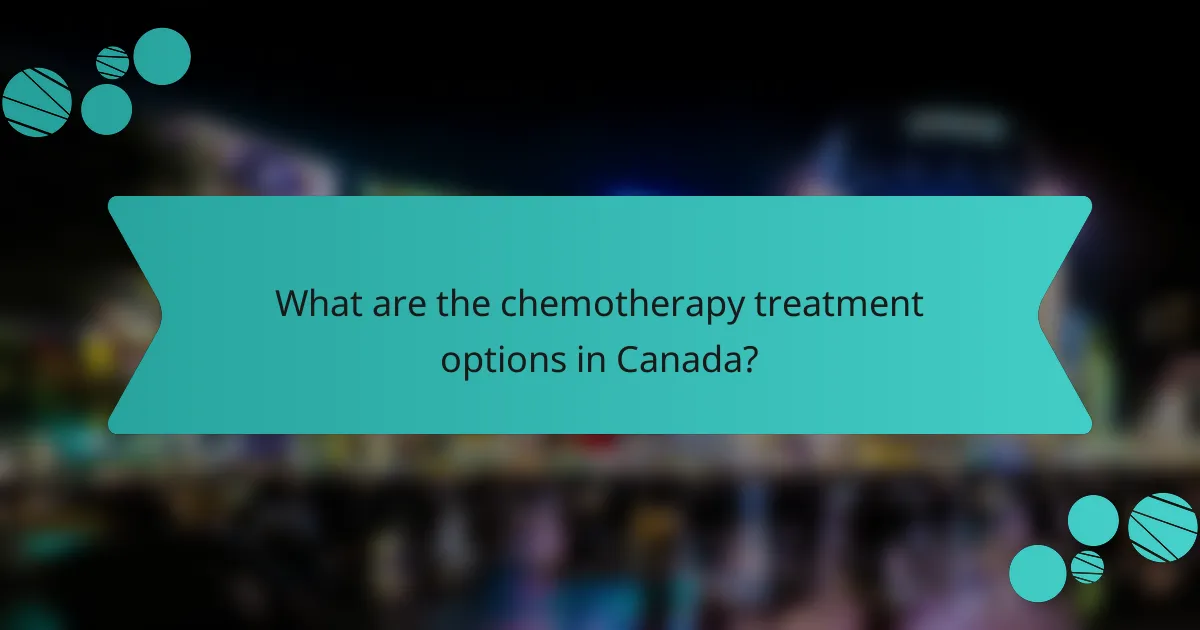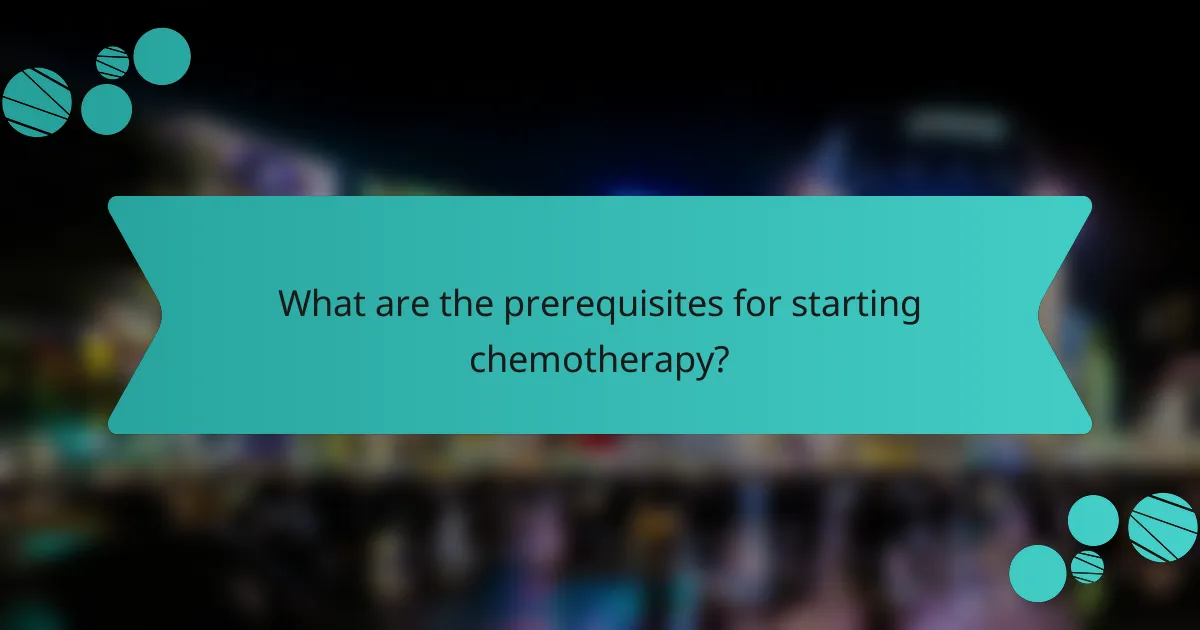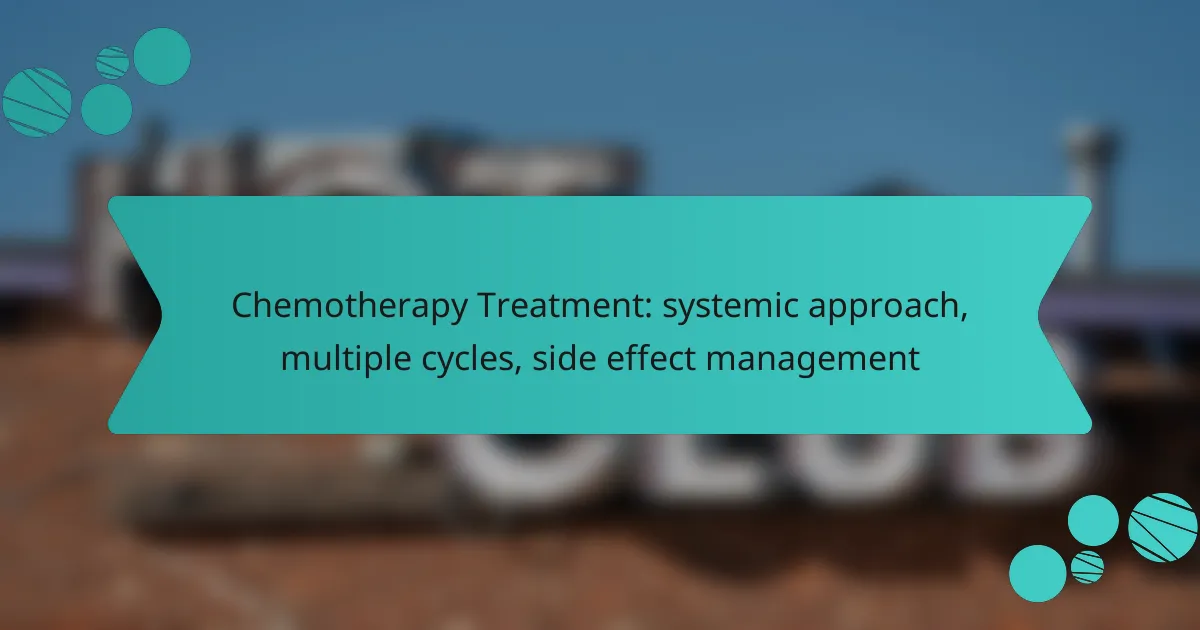Chemotherapy is a systemic treatment that utilizes powerful drugs to target and eliminate cancer cells throughout the body, making it essential for managing cancers that have metastasized. Administered in multiple cycles, this approach balances treatment periods with rest periods, allowing the body to recover while maximizing the drugs’ effectiveness. Effective side effect management is also crucial to ensure patient comfort and adherence to the treatment regimen.

What are the chemotherapy treatment options in Canada?
In Canada, chemotherapy treatment options include a variety of drugs that target cancer cells. These treatments are often administered in multiple cycles to maximize effectiveness while managing side effects.
Cyclophosphamide
Cyclophosphamide is an alkylating agent used in various cancer treatments, including breast cancer and lymphomas. It works by interfering with the DNA replication process in cancer cells, leading to cell death.
Patients typically receive cyclophosphamide intravenously or orally, often in combination with other chemotherapy agents. Side effects may include nausea, hair loss, and a risk of infection due to lowered white blood cell counts.
Doxorubicin
Doxorubicin is an anthracycline antibiotic that is effective against many types of cancer, such as leukemia and breast cancer. It functions by intercalating DNA strands, disrupting the cancer cell’s ability to replicate.
This drug is usually given by injection, and patients may undergo treatment in cycles. Common side effects include heart damage, nausea, and fatigue, which necessitate careful monitoring during treatment.
Paclitaxel
Paclitaxel is a taxane that works by preventing cancer cells from dividing. It is commonly used for ovarian, breast, and lung cancers. This drug stabilizes microtubules, which are essential for cell division.
Paclitaxel is administered intravenously, often in combination with other therapies. Side effects can include allergic reactions, neuropathy, and hair loss, requiring premedication and close observation.
Cisplatin
Cisplatin is a platinum-based chemotherapy drug used to treat various cancers, including testicular and bladder cancer. It damages DNA in cancer cells, leading to cell death.
This medication is typically given intravenously, and hydration is crucial to prevent kidney damage. Side effects may include nausea, vomiting, and electrolyte imbalances, which need to be managed proactively.
Gemcitabine
Gemcitabine is a nucleoside analog used primarily for pancreatic and non-small cell lung cancers. It inhibits DNA synthesis, effectively slowing down cancer cell growth.
Administered through an IV, gemcitabine is often part of combination therapy. Patients may experience side effects such as flu-like symptoms, low blood counts, and liver enzyme elevations, necessitating regular monitoring during treatment.

How does systemic chemotherapy work?
Systemic chemotherapy works by using powerful drugs to target and kill cancer cells throughout the body. This approach allows for the treatment of cancers that have spread beyond their original site, making it a crucial part of cancer management.
Targets cancer cells throughout the body
Systemic chemotherapy is designed to reach cancer cells that may be located in various organs and tissues. Unlike localized treatments, such as radiation, systemic therapy circulates through the bloodstream, affecting both visible tumors and microscopic cancer cells that could lead to recurrence.
This method is particularly effective for aggressive cancers or those diagnosed at advanced stages. By attacking cancer cells systemically, it aims to reduce tumor size and prevent metastasis, which is the spread of cancer to other parts of the body.
Administered via intravenous infusion
Most systemic chemotherapy treatments are delivered through intravenous (IV) infusion, allowing for rapid absorption into the bloodstream. This method ensures that the chemotherapy drugs are distributed efficiently throughout the body.
Infusions can vary in duration, typically lasting from a few minutes to several hours, depending on the specific drugs used and the treatment protocol. Patients may receive chemotherapy in cycles, with periods of treatment followed by rest to allow the body to recover.

What are the typical cycles of chemotherapy?
Chemotherapy typically involves multiple cycles, with each cycle consisting of a treatment period followed by a rest period. This approach allows the body to recover from the effects of the drugs while maximizing their effectiveness against cancer cells.
Common cycle lengths
Cycle lengths can vary widely depending on the specific chemotherapy regimen prescribed. Generally, cycles may last from two to six weeks, with some regimens requiring shorter or longer durations based on the drug combination and individual patient response.
For instance, a common cycle might involve treatment for one week, followed by a three-week rest period, totaling four weeks per cycle. Understanding the cycle length is crucial for patients to manage their schedules and expectations regarding treatment and recovery.
Frequency of treatments
The frequency of chemotherapy treatments is determined by the specific protocol and the patient’s overall health. Treatments may occur weekly, biweekly, or monthly, depending on the regimen and the cancer type being treated.
For example, some patients may receive chemotherapy once a week for several weeks, while others might have treatments every two to three weeks. It’s essential for patients to adhere to the treatment schedule to maintain the effectiveness of the therapy and monitor side effects properly.

What are the side effects of chemotherapy?
Chemotherapy can lead to various side effects due to its impact on rapidly dividing cells in the body. Common side effects include nausea, fatigue, hair loss, and an increased risk of infection, which can vary in severity and duration depending on the individual and the specific treatment regimen.
Nausea and vomiting
Nausea and vomiting are among the most common side effects of chemotherapy, often occurring shortly after treatment. Medications known as antiemetics are frequently prescribed to help manage these symptoms, and they can be effective in reducing the severity and frequency of nausea.
Patients are encouraged to eat small, frequent meals and avoid strong odors that may trigger nausea. Staying hydrated is also crucial, as dehydration can worsen these symptoms.
Fatigue
Fatigue is a prevalent side effect that can significantly impact daily life during chemotherapy. This fatigue is often described as a profound sense of tiredness that does not improve with rest and can persist for weeks or months after treatment ends.
To manage fatigue, patients should prioritize sleep, engage in light physical activity, and maintain a balanced diet. It’s essential to listen to the body and rest when needed, as pushing through fatigue can lead to further exhaustion.
Hair loss
Hair loss, or alopecia, is a common side effect of many chemotherapy drugs, affecting not only scalp hair but also body hair. The extent of hair loss can vary, with some patients experiencing thinning while others may lose all their hair.
Many patients find it helpful to prepare for hair loss by cutting their hair short before treatment or considering wigs and head coverings. This proactive approach can make the transition easier and help maintain confidence during treatment.
Increased risk of infection
Chemotherapy can weaken the immune system, leading to an increased risk of infections. This occurs because chemotherapy targets not only cancer cells but also healthy cells, including those in the bone marrow that produce white blood cells.
Patients should take precautions such as practicing good hygiene, avoiding crowded places, and staying up to date with vaccinations. It’s crucial to monitor for signs of infection, such as fever or unusual fatigue, and to contact a healthcare provider promptly if these occur.

How can side effects be managed during chemotherapy?
Managing side effects during chemotherapy is crucial for maintaining quality of life and treatment adherence. Effective strategies include using medications, supportive services, and nutritional guidance tailored to individual needs.
Anti-nausea medications
Anti-nausea medications, or antiemetics, are essential in preventing and alleviating nausea and vomiting associated with chemotherapy. Common options include 5-HT3 receptor antagonists like ondansetron and NK1 receptor antagonists such as aprepitant.
Timing is critical; these medications are often administered before chemotherapy and may be continued for several days afterward. Patients should communicate with their healthcare providers about the effectiveness and any side effects of these medications.
Supportive care services
Supportive care services encompass a range of therapies designed to alleviate symptoms and improve overall well-being during chemotherapy. These may include physical therapy, counseling, and pain management services.
Integrating supportive care can help address emotional and physical challenges, enhancing the patient’s ability to cope with treatment. Patients should inquire about available services at their treatment center, as many facilities offer comprehensive support programs.
Nutritional guidance
Nutritional guidance plays a vital role in managing side effects and maintaining strength during chemotherapy. A balanced diet rich in proteins, vitamins, and minerals can help support the immune system and combat fatigue.
Patients should focus on small, frequent meals and stay hydrated. Consulting with a registered dietitian can provide personalized recommendations tailored to individual dietary needs and preferences, ensuring optimal nutrition throughout the treatment process.

What are the prerequisites for starting chemotherapy?
Before starting chemotherapy, patients must undergo several evaluations to ensure they are suitable candidates for treatment. These prerequisites help assess overall health, cancer type, and any potential risks associated with chemotherapy.
Medical evaluations
Medical evaluations are critical to determine a patient’s readiness for chemotherapy. This typically includes a comprehensive physical examination, blood tests, and imaging studies to assess the cancer’s stage and the patient’s overall health status.
Common tests may include complete blood counts, liver and kidney function tests, and imaging techniques like CT or MRI scans. These evaluations help oncologists tailor the treatment plan to the individual, considering factors like age, existing health conditions, and the specific cancer type.
Patients should also discuss any medications they are currently taking, as some drugs may interfere with chemotherapy. Open communication with healthcare providers can help prevent complications and ensure a smoother treatment process.
